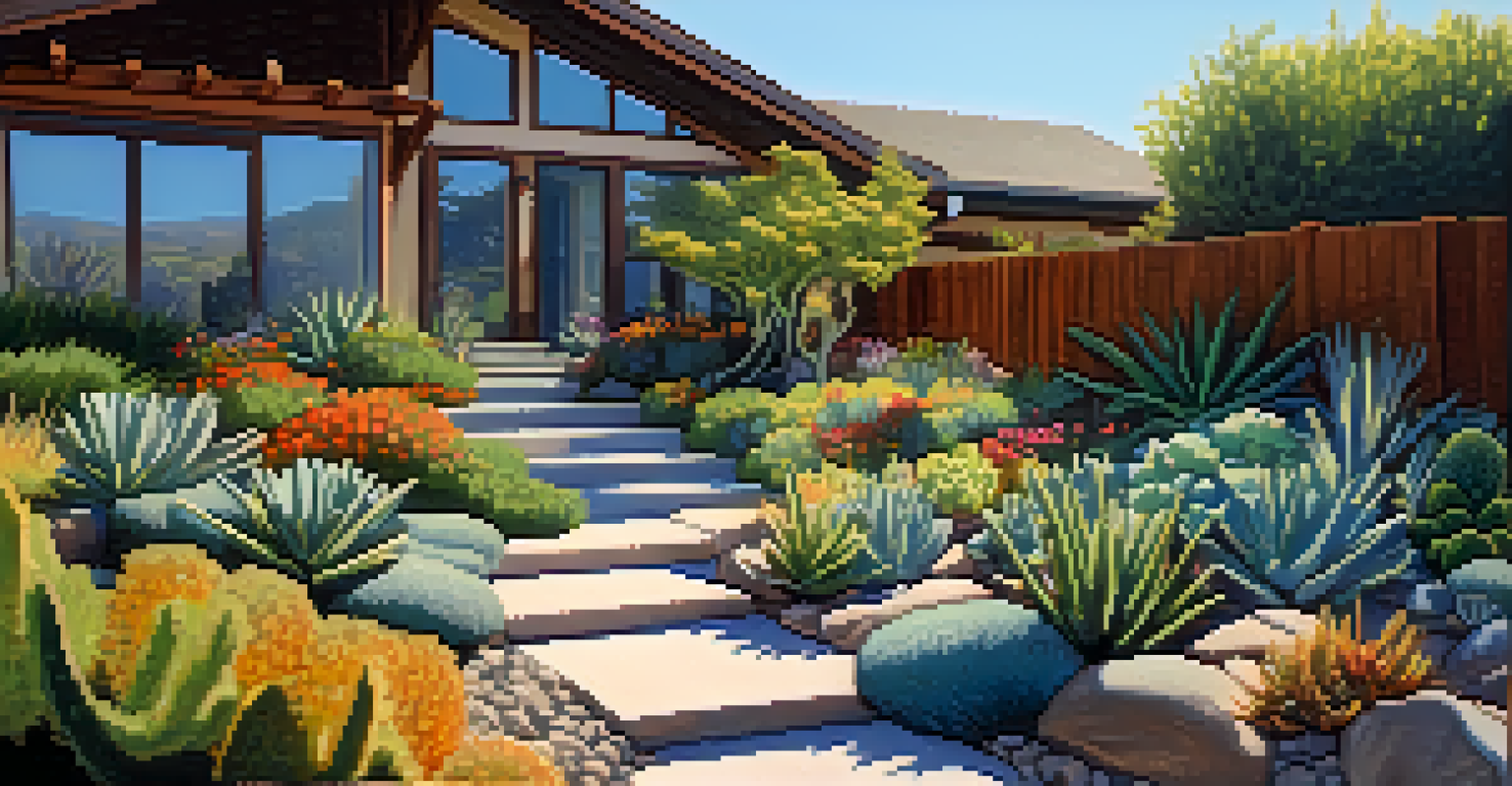Wildfire Risks: Addressing Malibu's Increasing Fire Threats

Overview of Malibu's Unique Wildfire Risks
Malibu, known for its stunning coastlines and luxurious homes, faces unique wildfire risks due to its geography. The region's mix of dry vegetation and hilly terrain creates a perfect storm for wildfires, especially during California's hot, dry months. As climate change continues to alter weather patterns, Malibu's vulnerability to these fires increases significantly. Understanding these risks is crucial for residents and policymakers alike, as it influences fire preparedness and community safety measures.
Wildfires do not respect borders or property lines. They are a reminder of our interconnectedness and the need for community preparedness.
The Santa Monica Mountains, which surround Malibu, are not only beautiful but also serve as a fire conduit. During the fire season, winds can whip through these hills, carrying embers from one area to another and igniting new fires. This phenomenon has been witnessed in past incidents, where flames spread rapidly, affecting homes and wildlife alike. Therefore, the geographic layout of Malibu plays a pivotal role in understanding the wildfire threat landscape.
Moreover, urban development in fire-prone areas has exacerbated the risks. Homes built in close proximity to natural landscapes increase the chances of property damage and loss of life during a wildfire. As Malibu continues to evolve as a desirable location, balancing development with ecological preservation becomes essential for mitigating fire risks in the future.
Recent Wildfire Incidents in Malibu
Recent years have seen a surge in wildfire incidents around Malibu, raising alarms among residents and officials. Notable fires, like the 2018 Woolsey Fire, devastated thousands of acres and destroyed numerous homes. These events serve as stark reminders of the ever-present danger wildfires pose to the region's communities. Each incident leaves lasting scars on the landscape and the psyche of its residents, reinforcing the need for proactive measures.

The Woolsey Fire alone highlighted the rapid spread of flames, fueled by strong winds and dry conditions. It burned over 96,000 acres, affecting not just Malibu but surrounding areas as well. The aftermath revealed the importance of preparedness, as many residents found themselves unready for such a catastrophic event. The lessons learned have led to increased community awareness and a push for better fire management strategies.
Malibu's Wildfire Risks Explained
Malibu's unique geography and climate increase its vulnerability to wildfires, necessitating proactive measures for safety.
In response to these incidents, local authorities have been working on fire prevention protocols and community education programs. Initiatives include creating defensible spaces around properties and promoting fire-resistant landscaping. These efforts aim to equip residents with the knowledge and tools necessary to protect their homes and families from future threats.
Understanding the Factors Contributing to Wildfires
Several factors contribute to the increasing frequency and intensity of wildfires in Malibu. One of the primary drivers is climate change, which has led to prolonged drought conditions and higher temperatures. These changes create an environment where vegetation dries out quickly, becoming prime fuel for wildfires. Consequently, understanding these environmental factors is key to addressing the wildfire threat.
The greatest weapon against stress is our ability to choose one thought over another.
Additionally, human activity plays a significant role in wildfire occurrences. From campfires left unattended to power lines sparking in dry conditions, the potential for human error is a critical factor. In Malibu, where outdoor activities are prevalent, educating the public on fire safety practices is vital to minimizing risks. By fostering a culture of responsibility and awareness, communities can significantly reduce the likelihood of accidental ignitions.
Lastly, land management practices can either mitigate or exacerbate wildfire risks. In areas where vegetation is not properly managed, overgrowth can fuel wildfires. Conversely, controlled burns and other land management strategies can help reduce fuel loads and create firebreaks. Striking a balance between maintaining the natural beauty of Malibu and implementing these practices is essential for long-term fire prevention.
The Role of Community Preparedness in Fire Safety
Community preparedness plays a vital role in enhancing fire safety and resilience against wildfires. Engaging residents in fire drills and educational programs ensures that everyone knows what to do in case of an emergency. Communities that are well-prepared can respond more effectively, ultimately saving lives and properties. This proactive approach fosters a sense of unity and shared responsibility among residents.
In Malibu, neighborhood associations and local governments are increasingly emphasizing the importance of fire preparedness. Initiatives range from creating evacuation plans to organizing community workshops focused on fire safety. These collaborative efforts not only educate residents but also strengthen relationships within the community, as people come together to address common concerns. When everyone is on the same page, the community becomes more resilient.
Community Preparedness is Key
Engaging residents in fire safety education and preparedness initiatives can significantly enhance community resilience against wildfires.
Moreover, technology has become an invaluable tool in community preparedness. With the rise of apps providing real-time fire alerts and evacuation routes, residents can stay informed and make timely decisions during emergencies. This integration of technology into preparedness efforts enhances overall safety, making it easier for residents to navigate the complexities of wildfire threats.
Mitigating Risks: Fire-Resistant Landscaping Tips
One effective way to mitigate wildfire risks is through fire-resistant landscaping. Homeowners can choose plants that are less likely to ignite, such as succulents and other drought-resistant species. Additionally, maintaining a defensible space around properties by clearing dead vegetation and keeping grass trimmed can significantly reduce fire hazards. These landscaping choices not only enhance the beauty of homes but also provide crucial protection against wildfires.
Creating zones around homes can also be beneficial. The first zone, closest to the home, should be meticulously maintained, while the outer zones can feature more natural vegetation. This layered approach minimizes the risk of flames reaching the house. Furthermore, using non-flammable materials for hardscaping, such as stone or gravel, can help further protect against fire spread. Every small change contributes to a larger strategy of risk reduction.
Community involvement in fire-resistant landscaping initiatives can amplify these efforts. Local workshops and programs can educate residents on best practices and provide resources for implementing these strategies. By fostering a collaborative environment focused on fire safety, Malibu can enhance its overall resilience against wildfires, creating a safer space for everyone.
Government Initiatives and Policies for Fire Management
Government initiatives play a crucial role in managing wildfire risks in Malibu. Local and state agencies are developing policies aimed at improving fire safety and response strategies. These initiatives often include increased funding for fire departments, improved resources for firefighting, and enhanced community education programs. By investing in these areas, authorities can better prepare for and respond to wildfire threats.
Additionally, regulations around land use and building codes have been updated to prioritize fire safety. New constructions in fire-prone areas are now required to meet stricter standards, such as using fire-resistant materials. This proactive approach helps ensure that new homes are built with wildfire risks in mind, contributing to overall community safety. Continuous evaluation of these policies is vital to adapt to changing environmental conditions and community needs.
Government Policies for Fire Safety
Local and state agencies are implementing stricter regulations and funding for fire management to improve safety and response strategies in Malibu.
Finally, collaboration between various agencies, including fire departments, environmental organizations, and local governments, is essential for effective fire management. This teamwork allows for the sharing of resources and information, creating a unified front against wildfire threats. By working together, Malibu can develop comprehensive strategies that address both immediate and long-term wildfire risks.
Looking Ahead: The Future of Fire Safety in Malibu
As Malibu faces an evolving landscape of wildfire risks, the future of fire safety will depend on continued vigilance and adaptation. Ongoing education and community engagement will be crucial in ensuring that residents remain informed and prepared. By fostering a culture of awareness, Malibu can empower its residents to take proactive steps in safeguarding their homes and neighborhoods. The road ahead requires a commitment to resilience and adaptability in the face of change.
Innovative technologies will also play a significant role in shaping fire safety measures. From advanced early warning systems to enhanced firefighting equipment, these tools can significantly improve response times and effectiveness during wildfires. As research and development in fire management continue, Malibu can leverage these advancements to bolster its defenses against future threats. Staying ahead of the curve will be vital for maintaining safety in this fire-prone region.

Ultimately, collaboration between residents, local authorities, and environmental organizations will be key to fostering a sustainable future. By working together, Malibu can not only mitigate current wildfire risks but also develop a robust framework for fire safety that can withstand the test of time. Embracing this cooperative spirit will help ensure that Malibu remains a safe and beautiful place to live, even in the face of increasing fire threats.